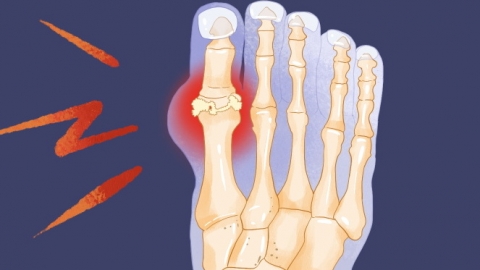What can be done for gout-related foot pain?
Generally, foot pain caused by gout may be due to reasons such as deposition of urate crystals, foot joint strain, poor control of hyperuricemia, acute gouty arthritis attacks, or chronic gouty arthritis. It is recommended to seek timely medical attention, identify the cause, and then improve symptoms under a doctor's guidance through general treatment, medication, or surgical intervention. A detailed explanation is as follows:

1. Urate Crystal Deposition: When uric acid concentration in the blood is excessively high, urate crystals form and deposit in the foot joints, irritating the joints and causing severe pain, often suddenly occurring at night. During an attack, bed rest with the affected limb elevated to minimize movement, applying cold compresses to the painful area, and reducing swelling and pain are recommended. Heat application should be avoided as it may exacerbate inflammation.
2. Foot Joint Strain: Prolonged walking, standing, or intense physical activity can damage foot joints, making them prone to urate crystal deposition and resulting in pain, commonly affecting the first metatarsophalangeal joint. Reducing foot weight-bearing, choosing loose and soft shoes, avoiding high heels or tight footwear, and timely rest after strain are advised to prevent excessive joint use.
3. Poor Control of Hyperuricemia: Long-term elevated blood uric acid levels that are not effectively managed lead to continuous urate deposition, repeatedly causing foot pain accompanied by joint redness and swelling. Patients should follow medical advice to use medications such as allopurinol tablets, febuxostat tablets, and benzbromarone tablets to lower blood uric acid levels. Strict restriction of high-purine food intake and increased consumption of warm water to promote uric acid excretion are also necessary.
4. Acute Gouty Arthritis Attack: Urate crystals within the joint trigger an acute inflammatory response, causing severe pain, swelling, and increased skin temperature in foot joints, often affecting a single foot joint. Patients should follow medical instructions to use medications such as colchicine tablets, diclofenac sodium sustained-release tablets, and etoricoxib tablets for rapid pain relief. Physical activity should be avoided during the acute phase, and light activities can gradually resume once the pain subsides.
5. Chronic Gouty Arthritis: Long-term recurrent attacks lead to bone destruction and joint deformities in the foot, prolonging pain duration and intensifying pain during movement, which affects normal walking. If necessary, joint debridement surgery may be performed to remove urate crystals within the joint and improve joint function.
Daily management should include maintaining a low-purine diet, avoiding alcohol and high-sugar beverages, keeping a regular作息 (sleep-wake cycle), and avoiding late nights and excessive fatigue. Regular monitoring of blood uric acid levels is essential to adjust treatment plans accordingly, reduce foot joint strain, and implement comprehensive management to decrease the frequency of pain episodes and maintain foot health.






